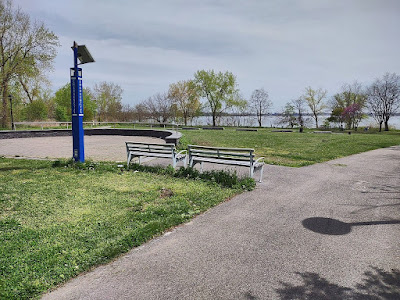Nestled on the shores of the East River, where it meets the Bronx River, lies Soundview Park – a sprawling 205-acre green space pulsating with history and natural beauty. From its humble beginnings as marshland to its current status as the "Gateway to the Bronx River," the park's story is intricately woven with local lore, geological wonders, and the vision of dedicated individuals. Let's embark on a journey through time, uncovering the layers that make Soundview Park such a cherished landmark.
History of Soundview Park
 |
| Image of Soundview Park, Bronx, NY Source: Wikipedia |
Early Foundations: Ludlow's Black Rock Farm
In the 1830s, the Ludlow family held sway over Clason Point, including what would later emerge as Soundview Park. Ludlow's Black Rock Farm, a vast expanse, encompassed Barrett's Creek, named after Samuel Barrett, a Clason Point pioneer. The farm derived its name from a colossal boulder in a salt marsh at Ludlow's Creek and the Bronx River junction. Composed of gneiss, a coarse-grained metamorphic rock, this black rock narrates a geological saga spanning millions of years.Believed to be a glacial erratic transported by a glacier some 10,000 years ago, the boulder once confounded settlers who, in their early observations, mistook it for a meteorite. Today, this monumental rock finds its place in Soundview Park, an enduring testament to the park's geological intrigue.
The Birth of Lafayette Park: A Contested Legacy
The City of New York's acquisition of the original 93 acres in 1937 unveiled a landscape dominated by marshland, seemingly unsuitable for park use. Local lore contends that Robert Moses, the Parks Commissioner, initially christened the site Lafayette Park, honoring Marquis de Lafayette (1757-1834), a pivotal figure in both the American and French revolutions. However, a tug-of-war ensued as local residents sought a name reflecting the neighborhood's essence.
Ultimately yielding to local sentiment, the park metamorphosed into Soundview Park. The name, inspired by historical maps designating the East River as Long Island Sound, pays homage to the park's geographical roots. Soundview Avenue, on the northwest side, further ties the park to its colonial past, being part of the road leading to Clason Point.
Expansion and Renovation: An Ongoing Evolution
The city's commitment to enhancing Soundview Park materialized in the acquisition of an additional 63 acres in 1940 through condemnation. Subsequent expansions in 1953 and 1967 further broadened the park's footprint. A pivotal moment in the park's evolution occurred in 1994 with the renovation of sewer systems, control vaults, and the installation of dams, modernizing and fortifying the park's infrastructure.
The following years witnessed targeted improvements, with the playground receiving a facelift in 1997, and essential repairs to sidewalks and pavements completed in 1998. Soundview Park, often hailed as the "Gateway to the Bronx River," sits at the confluence where the Bronx River converges with the East River. Notably, the Bronx River transforms from a saltwater river to the only freshwater river in New York City just north of Soundview. The park, adorned with sweeping views of both the Bronx and East Rivers, stands as a testament to the harmonious celebration of nature's beauty and the city's rich history.
A Living Chronicle: Soundview Park Today
As Soundview Park continues to evolve, it remains a living chronicle, weaving together geological wonders, historical legacies, and the ongoing commitment of the city to create a vibrant space for community engagement. From Ludlow's Black Rock Farm to the contested legacy of Lafayette Park and the vibrant present as Soundview Park, the journey unfolds, inviting residents and visitors alike to explore and embrace the multifaceted story etched into the heart of this urban sanctuary. The park serves not only as a green haven but as a testament to the resilience of nature and the enduring spirit of community that weaves through the tapestry of time.

